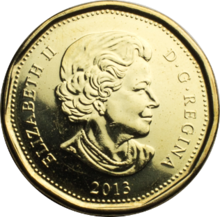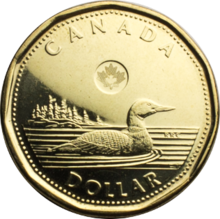Loonie
| Canada | |
| Value | 1 CAD |
|---|---|
| Mass | 6.27g (was 7.00g before 2012) g |
| Diameter | 26.5 mm |
| Thickness | 1.95 mm |
| Edge | Eleven-sided, smooth |
| Composition | 1987–2011 91.5% Ni, 8.5% bronze plating (88% Cu, 12% Sn) 2007–2011 some coins used brass plating instead 2012– steel, brass plating |
| Years of minting | 1987– present |
| Catalog number | - |
| Obverse | |
 |
|
| Design | Elizabeth II, Her Majesty the Queen in Right of Canada |
| Designer | Susanna Blunt |
| Design date | 2003 |
| Reverse | |
 |
|
| Design | Common loon in water |
| Designer | Robert-Ralph Carmichael |
| Design date | 1987 |
The Canadian one dollar coin, commonly called the loonie, is a gold-coloured one-dollar coin introduced in 1987. It bears images of a common loon, a bird which is common and well known in Canada, on the reverse, and of Queen Elizabeth II on the obverse. It is produced by the Royal Canadian Mint at its facility in Winnipeg.
The coin's outline is an 11-sided curve of constant width. Its diameter of 26.5 mm and its 11-sidedness matched that of the already-circulating Susan B. Anthony dollar in the United States, and its thickness of 1.95 mm was a close match to the latter's 2.0 mm. Its gold colour differed from the silver-coloured Anthony dollar; however, the succeeding Sacagawea and Presidential dollars matched the loonie's overall hue. Other coins using a curve of constant width include the 7-sided British twenty pence and fifty pence coins (the latter of which has similar size and value to the loonie, but is silver in colour).
The coin has become the symbol of the Canadian dollar: media often discuss the rate at which the loonie is trading against other currencies. The nickname loonie (huard in French) became so widely recognized that in 2006 the Royal Canadian Mint secured the rights to it. When the Canadian two-dollar coin was introduced in 1996, it was in turn nicknamed the "toonie" (a portmanteau of "two" and "loonie").
...
Wikipedia
